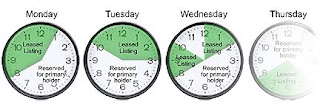Key portions of presentations given by Spectrum Bridge
Post 2
In recent years, the FCC has taken significant steps to facilitate the development of secondary markets and spectrum usage rights. Through these efforts, a number of options have opened up that allow efficient usage of limited frequencies like never before.
GEOGRAPHIC PARTITIONING is one solution. Let’s say that in a hypothetical situation, a company called “TriCounty Telephone” operates in a tricounty area. They have been awarded a license that covers 12 counties in a BTA. Knowing that their business plan allows them to operate in 3 co
 unties only, what can they do with the remaining 75% of the license? Through geographic partitioning, they can operate in their three counties and sell or lease the remaining nine counties to create additional revenue streams – thereby earning money off a day to day business model, as well as incurring a new revenue stream from the remainder of the partitioned license.
unties only, what can they do with the remaining 75% of the license? Through geographic partitioning, they can operate in their three counties and sell or lease the remaining nine counties to create additional revenue streams – thereby earning money off a day to day business model, as well as incurring a new revenue stream from the remainder of the partitioned license.In another case, let’s say that “Mobile Corp” won the A block of AWS for 20 MHz, but they know through market research and demographics studies with a spectrum management tool that they will only ever need to use 10MHz. What can Mobile Corp to do with the remaining 50% of the license? The answer is DISAGGREGATION.

By dividing spectrum (disaggregating) into smaller portions in the frequency domain, they can use what is needed and monetize the remaining overage. The flexibility in secondary market rules promote spectrum efficiency and allow commoditization of spectrum assets.
TIME SHARING is another way that companies can create an additional revenue stream from spectrum. Let’s say that there is a utility company wishing to do meter reading between the hours of 12 and 4am. It may not make sen
 se for a company to purchase spectrum to satisfy spectrum they would use only 15% of the time. An option for a utility they may consider is time sharing; where they could allow another entity to rent spectrum for a set period of time.
se for a company to purchase spectrum to satisfy spectrum they would use only 15% of the time. An option for a utility they may consider is time sharing; where they could allow another entity to rent spectrum for a set period of time.Spectrum Bridge products make it easy to move beyond the wholesale mentality and create “right-sized” spectrum offerings that create more flexibility and affordability to buyers, while creating higher ROI for sellers. Demographic and analytic tools built into offerings such as SmartWaves can be used to determine which counties to focus networks on, thereby leaving the remaining underused spectrum to be offered on an online marketplace for monetization.
Next in the series, we’ll discuss the online marketplace for spectrum…









No comments:
Post a Comment